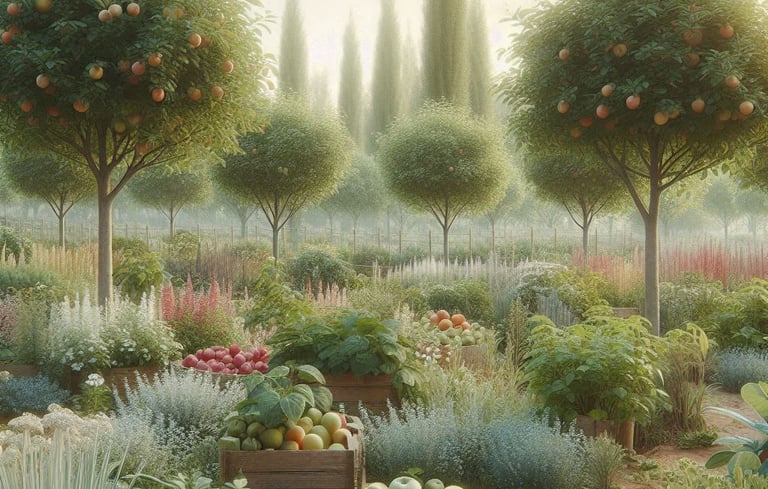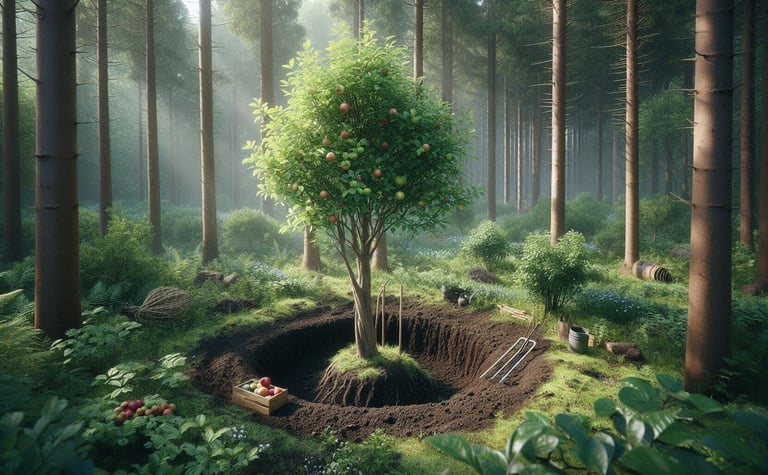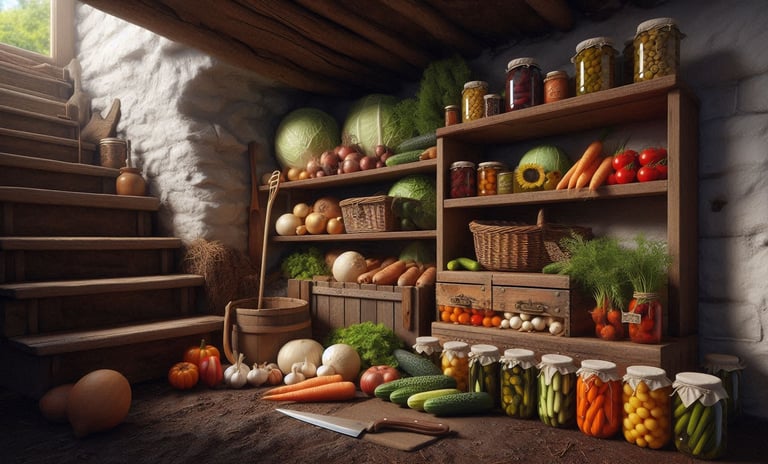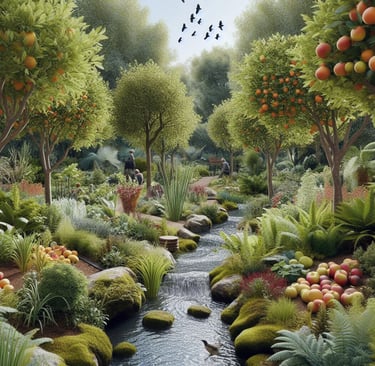Building a Self-Sustaining Food Forest: A Step-by-Step Guide
Discover how to create a self-sustaining food forest on your property. Learn the principles of permaculture, design tips, and plant recommendations to grow your own thriving, low-maintenance ecosystem
HOMESTEADING
Kathrine-Anne Hill
9/5/202410 min read
Introduction to Food Forests
The term food forest or forest garden refers to a type of self-sufficient ecosystem where plants grow in response to natural forces and produce an abundance of edible species. A food forest is a type of ecosystem that mimics the interactions between different types of vegetation, unlike traditional gardens that rely heavily on external factors. Through this method, a durable, low-maintenance system is established that provides countless ecological benefits as well as economic and social opportunities.
Increasing biodiversity can be one of the key benefits of a food forest. From tall fruit trees to grass-covered herbs, a food forest is the building block of an intricate web of life. The result is a richer plant matter that attracts beneficial insects, birds, and other wildlife, leading to a reduction in pests and diseases within the self-sustaining ecosystem.
A food forest has the potential to improve the health of soil. Conventional farming involves repetitive planting of crops and the use of chemical fertilizers and pesticides, which can lead to soil depletion over time. Conversely, a food forest employs natural mulches and compost to create rich soil. The presence of deep-rooted plants also facilitates soil aeration and moisture retention, which results in long-term productivity without the use of chemicals.
A food forest's ability to provide a constant supply of fresh, organic produce results in significant economic benefits for grocery stores. For families who are committed to eating well, this can be a substantial saving. Also, surplus crops can be sold or auctioned off, creating connections within the community and potentially generating some profit.
Worldwide, there are examples of profitable food forests that are unique to their respective regions and operate on the same principles. Seattle, Washington is home to the Beacon Food Forest; whose seven-acre land serves as a community initiative that distributes free food to people for all to enjoy. Similarly, the Martin Crawford Forest Garden in Devon, UK, has been flourishing for over two decades, demonstrating the ability of this technique to maintain and enhance plant productivity. Overall, food forests are a sustainable way to grow food for the planet, economy and society. Creating a food forest can be a rewarding path to self-sufficiency and environmental stewardship, suitable for both seasoned and novice gardeners.
Planning and Designing Your Food Forest
Deliberate planning and design are necessary to establish a self-sustaining food forest that functions as the cornerstone of an active ecosystem. It is important to choose the right site; ideally, the land has good topography, is easily accessible and close to your home so it can be maintained with ease. The analysis of your local climate is equally important; knowledge of seasonal changes, temperature levels, and precipitation amounts will assist you in selecting plant species that grow well in different areas.
Soil health cannot be overlooked. A thorough soil examination can uncover crucial information about soil pH, composition, and nutrient levels to adjust it for various plant species. The mapping of your land is essential in determining its natural resources and constraints. Observe the influence of sunlight, water sources, and common wind patterns. The placement and overall design of plants will be heavily influenced by these factors.
The foundation for a long-lasting food forest is established through the use of design principles such as zoning and layering. The division of your space is determined by the amount of use it receives, with high-value plants located closer to your living area and less demanding varieties positioned farther away. The use of layers, which is influenced by forest ecology, involves covering various canopy levels, such as tall trees, understory plants, shrubs, herbs, groundcovers and root crops. This approach enhances spatial efficiency by emulating natural growth patterns.
A thriving food forest thrives on diversity. A varied ecosystem can lead to fewer pests, better pollination, and enhanced soil quality. The design should reflect the diverse practices of permaculture. Permaculture, with its reliance on natural ecosystems and ecological principles, underscores the significance of sustainable agriculture. Employing methods like polyculture, companion planting, and incorporating native species ensures that your food forest will be more productive and enduring.
While planning ahead, have access to essential materials and equipment.. Consider using digital mapping software, utilizing local agricultural extensions for guidance on planting practices, or consulting with local extension providers. With great care and planning, you'll create a self-sufficient food supply chain that will thrive for generations.
Selecting Plants and Trees for Your Food Forest
Picking plants and trees that grow in your food forest is essential for sustaining the ecosystem. Among the first rules of plant selection is to give preference to indigenous species. Native plants are well-adapted to the local climate and soil conditions, making them easier to maintain and less laborious to care for. By incorporating perennials, you can create a landscape that is more resilient and requires less energy over time. Perennials, which can live for more than two years, provide continuous harvests and help stabilize the soil, reducing erosion and increasing the need for replanting.
The establishment of a food forest can be achieved through companion planting. In order to enhance mutual growth, yield, and resilience in each species, this technique is used by planting different species together. The "Three Sisters," also known as corn, beans, and squash, work together effectively because of the fact that corn provides long stalks for beans to climb, which helps retain nitrogen in the soil, while squash spread weeds on the ground. Plants should be mixed in such a way that it is suitable for your climate and soil type, including fruits, nuts, vegetables and herbs and medicinal plants. Various plants and vegetables, such as apples, pecans, leafy greens like rosemary and echinacea, thrive in different climates and can offer various benefits.
A fundamental concept in food forests is the occurrence of layering, which mirrors the composition and type of forest observed in nature.. Starting from the canopy trees, such as chestnuts and walnut bushes, which form the uppermost layer. Below them, there are understory trees like plums or hazelnuts, and shrubs such as blueberries or elderberries. Herbaceous vegetables and culinary herbs can be present in the herbaceous layer, whereas ground cover plants like clover are effective in resorbing soil and maintaining moisture. Through the use of root crops and climbing plants, all layers of the ecosystem can be stimulated to maximize productivity.
Pollinators and nitrogen-fixing plants are essential components of your food forest's health and productivity. Use flowering plants such as lavender and flowering herbs to attract bees, butterflies and other pollinators. By converting the atmospheric nitrogen into forms that plants can absorb, legumes and certain trees like black locust are known to be nitrogen-fixers that can improve soil fertility. By incorporating diverse species that are resistant to pests into your food forest, you can enhance its resilience and maintain a balance of ecosystem components.
Planting Your Food Forest
When you plant your food forest, take very careful steps to ensure that your plants grow in a sustainable manner. The first step is to thoroughly prepare the soil. To begin with, assess the nutrient composition and pH of your soil. Utilize compost or organic matter to improve the soil's structure and fertility. A flourishing ecosystem can only be created through this initial enrichment.
Your soil is ready when it's time to start planting. Make holes deep enough to fit the roots of your plants. For trees and larger shrubs, the root ball's width should be at least double that of the hole. Insert the plant into that opening and then backfill the soil with any other mixture, pressing gently down through holes to air-test. The plants can be nourished by adding water right after planting to aid in their growth.
Timing is another critical aspect. The planting schedule of various species is dependent on the type of fruit they produce, but most fruit-bearing plants prefer to be planted in early spring or autumn. The seasons have moderate temperatures and high humidity levels, which facilitate the growth of roots. The specific requirements of each plant species should be considered when deciding on the most suitable planting time.
To prevent overcrowding and competition for resources, spacing must be implemented. Apply specific standards for every plant, which usually range from shrubs by several feet to larger trees by a considerable amount.). The proper spacing ensures that each plant can obtain sufficient sunlight, air, and nutrients.
To maintain soil fertility, eliminate weeds, and regulate the temperature, mulching around your plants' base is an effective method. Organic mulches such as wood chips, straw or leaves are fine to use. The soil becomes more fertile as they break down over time. Moreover, incorporate composting into your diet to continuously replenish nutrients in your food forest.
The safeguarding of young plants is also essential. To prevent pests, use netting or fencing as a form of protection. During extreme weather, plants can be protected by using frost cloths or shade covers as needed to keep them safe. Lastly, it's advantageous to establish a timeframe for your planting. Soil preparation is the first step, before planting during optimal times; also incorporating soil enrichment such as mulching and composting.
Maintaining and Cultivating Your Food Forest
Preserving food forests require regular maintenance to ensure their survival. Maintaining ecosystem health and productivity requires frequent attention. We must implement the right practices of pruning, weeding and mulching. Why? Pruning is essential for maintaining plant shape, stimulating fruit growth, and preventing illnesses. For every species of plant, pruning is done at the right time; dead or diseased branches should be pruned and healthy growth should follow.
The act of weeding is an essential function that prevents unwanted plants from competing with your food-producing species. Through selective weeding, beneficial plants can be nurtured while aggressive invasives are discouraged. Utilizing mulches like wood chips, leaves, and straw helps to maintain moisture levels, eliminate weeds in the soil, promote fertility by adding organic matter gradually as it decompose.
It's crucial to closely monitor and engage with your food forest. Inspecting the ecosystem in advance can help identify potential issues like pests or diseases, allowing for timely interventions. Employing organic pest control methods, such as introducing beneficial insects or using natural deterrents, can manage unwanted pests without resorting to chemicals. Integrated Pest Management (IPM) seeks to establish a stable environment that regulates pest populations. The purpose of the Integrated Food Security Phase Classification (IPC) is to provide decision-makers with a rigorous, evidence- and consensus-based analysis of food insecurity and acute malnutrition situations, to inform emergency responses as well as medium- and long-term policy and programming.
Animals such as chickens and bees can contribute to the self-reliance of a food forest by providing additional sustenance. The control of insect infestations is supported by chickens, and their dung provides essential nutrients to the soil. Additionally, The use of bees for pollination is essential, as it enhances the productivity of fruit-bearing plants.
Implementing sustainable practices like composting is crucial. Composting enhances soil fertility by recycling organic waste. Methods such as rainwater harvesting and swale utilization are effective for water management, supporting the verdant growth of a food forest. Employing cover crops and green manures can also greatly enrich the soil over time. The upkeep of a food forest demands continuous dedication and interaction with the environment. Embracing these methods benefits not just the food forest but also aids in the broader environmental health and sustainability.
Harvesting and Enjoying the Benefits of Your Food Forest
After years of planning and nurturing, the harvest is the most rewarding part of your food forest journey. To guarantee the produce is sufficiently ripe, careful harvesting is essential. When fruits such as apples and pears are easily cut, they should be pulled from the branch gently, while berries often require a slight tug. Harvesting vegetables and herbs early in the morning ensures that they are both nutritious and delicious, as well as maintains their moisture content.
The next step is to maintain and protect the abundance of your food forest. Alternatively, loosely-hanging baskets in a cool, dark setting are ideal for short-term storage of fruits and vegetables. Whether you're cultivating your produce through canning, freezing, or dehydrating. In addition to extending the shelf life of your produce, jams, jellies, pickles, and dried herbs also provide versatility in their use throughout the year.
The bounty can serve purposes beyond just providing fresh food. The herbs from your food forest can be dried and stored for the purpose of making teas, tinctures, and salves at home. Echinacea, chamomile and many others are natural plants that can aid in health and well-being.
The ecological advantages of establishing a food forest are significant. A higher biodiversity, a better habitat for wildlife, and improved soil quality are some of the benefits. Native flora and fauna thrive, contributing to the balance of ecosystems.' A safe haven for birds, insects, and small mammals in your food forest, aiding in pest control and pollination.
The benefits are exemplified by the stories of individuals who have established and cherished their own food forests.' To give an example, Jane from Oregon describes the pleasure she derives from walking through her garden and picking out fresh produce each day, while Carlos from Florida emphasizes the fact that his food forest has greatly increased bird activity. These stories are both motivational and informative in demonstrating how to make the most of this sustainable practice.
Affiliate Disclaimer:
Please note that some of the links in this article are affiliate links. This means that if you click on these links and make a purchase, I may receive a small commission at no additional cost to you. This commission helps support the maintenance and growth of this website and allows me to continue providing valuable information and recommendations. Rest assured, I only recommend products and services that I have personally used or thoroughly researched. Your support is greatly appreciated! “As an Amazon Associate I earn from qualifying purchases.”. For full disclosure see our Privacy Policy and Terms and Conditions here.













